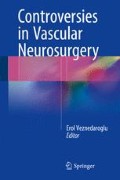Abstract
Stroke is the leading cause of disability in adults in North America [1]. In the last 20 years, interest has soared in search of a reperfusion therapy for ischemic stroke caused by vessel occlusion. The revolutionary trial by the National Institute of Neurologic Disorders and Stroke (NINDS) showed that intravenous thrombolysis could be achieved with an intravenous tissue plasminogen activator (tPA). The effectiveness of tPA is time-dependent, and benefit has been shown up to 4.5 h after the onset of stroke. Although tPA can be initiated quickly after a new ischemic stroke is suspected, the short treatment window excludes many patients from therapy. There are also other risks such as development of asymptomatic and symptomatic intracranial hemorrhage (ICH) as well as failure of therapy [2, 3]. These limitations in IV tPA therapy have led to the development of procedural-based interventions such as intra-arterial thrombolytics and mechanical thrombectomy. In 2013, utilization of endovascular therapy was called into question by three randomized controlled trials, showing no benefit of endovascular treatment of stroke compared to standard care or IV tPA [4–6]. These trials used first-generation devices and intra-arterial chemical thrombolysis as the mainstay of treatment. Recruitment was also not limited to patients with a radiographic documentation of proximal large vessel occlusion. Despite different trial methods and designs, none showed benefit of endovascular therapy compared to less invasive measures (although no harm was shown). As these trial results were published, three other multicenter RCTs were enrolling patients to compare endovascular treatment to standard care in managing acute ischemic stroke. The trials ESCAPE, MR CLEAN, and EXTEND-IA all concluded that endovascular treatment of acute vessel occlusion in the anterior circulation was superior to medical management with IV tPA alone [7–9]. These new trials utilized the recent technology of stent retrievers. They also required radiographic evidence of proximal vessel occlusion and noninvasive imaging to assess tissue viability. Despite their differences in trial design, these recent trials all showed a benefit to patients with acute ischemic stroke caused by proximal vessel occlusion from endovascular therapy. In this chapter, we will give a brief history of endovascular therapy for stroke, including the changes in technology, and discuss the three primary equivocal studies for stroke intervention as compared to the three recent studies, which favor endovascular therapy for the treatment of acute ischemic stroke.
Access this chapter
Tax calculation will be finalised at checkout
Purchases are for personal use only
References
Mozaffarian D, Benjamin EJ, Go AS, et al. Heart disease and stroke statistics – 2015 update: a report from the American Heart Association. Circulation. 2015;131(4):e29–322.
The National Institute of Neurological Disorders and Stroke rt-PA Stroke Study Group. Tissue plasminogen activator for acute ischemic stroke. N Engl J Med. 1995;333(24):1581–7.
Hacke W, Kaste M, Bluhmki E, et al. Thrombolysis with alteplase 3 to 4.5 hours after acute ischemic stroke. N Engl J Med. 2008;359(13):1317–29.
Broderick JP, Palesch YY, Demchuk AM, et al. Endovascular therapy after intravenous t-PA versus t-PA alone for stroke. N Engl J Med. 2013;368(10):893–903.
Ciccone A, Valvassori L, Nichelatti M, et al. Endovascular treatment for acute ischemic stroke. N Engl J Med. 2013;368(10):904–13.
Kidwell CS, Jahan R, Gornbein J, et al. A trial of imaging selection and endovascular treatment for ischemic stroke. N Engl J Med. 2013;368(10):914–23.
Berkhemer OA, Fransen PS, Beumer D, et al. A randomized trial of intraarterial treatment for acute ischemic stroke. N Engl J Med. 2015;372(1):11–20.
Campbell BC, Mitchell PJ, Kleinig TJ, et al. Endovascular therapy for ischemic stroke with perfusion-imaging selection. N Engl J Med. 2015;372(11):1009–18.
Goyal M, Demchuk AM, Menon BK, et al. Randomized assessment of rapid endovascular treatment of ischemic stroke. N Engl J Med. 2015;372(11):1019–30.
Zeumer H, Hacke W, Ringelstein EB. Local intraarterial thrombolysis in vertebrobasilar thromboembolic disease. AJNR Am J Neuroradiol. 1983;4(3):401–4.
del Zoppo GJ, Higashida RT, Furlan AJ, Pessin MS, Rowley HA, Gent M. PROACT: a phase II randomized trial of recombinant pro-urokinase by direct arterial delivery in acute middle cerebral artery stroke. PROACT Investigators. Prolyse in Acute Cerebral Thromboembolism. Stroke J Cereb Circ. 1998;29(1):4–11.
Furlan A, Higashida R, Wechsler L, et al. Intra-arterial prourokinase for acute ischemic stroke. The PROACT II study: a randomized controlled trial. Prolyse in Acute Cerebral Thromboembolism. JAMA. 1999;282(21):2003–11.
Jayaraman MV, Hussain MS, Abruzzo T, et al. Embolectomy for stroke with emergent large vessel occlusion (ELVO): report of the Standards and Guidelines Committee of the Society of NeuroInterventional Surgery. J Neurointerventional Surg. 2015;7(5):316–21.
Smith WS, Sung G, Starkman S, et al. Safety and efficacy of mechanical embolectomy in acute ischemic stroke: results of the MERCI trial. Stroke J Cereb Circ. 2005;36(7):1432–8.
Smith WS. Safety of mechanical thrombectomy and intravenous tissue plasminogen activator in acute ischemic stroke. Results of the multi Mechanical Embolus Removal in Cerebral Ischemia (MERCI) trial, part I. AJNR Am J Neuroradiol. 2006;27(6):1177–82.
Penumbra Pivotal Stroke Trial I. The penumbra pivotal stroke trial: safety and effectiveness of a new generation of mechanical devices for clot removal in intracranial large vessel occlusive disease. Stroke J Cereb Circ. 2009;40(8):2761–8.
Saver JL, Jahan R, Levy EI, et al. Solitaire flow restoration device versus the Merci Retriever in patients with acute ischaemic stroke (SWIFT): a randomised, parallel-group, non-inferiority trial. Lancet. 2012;380(9849):1241–9.
Nogueira RG, Lutsep HL, Gupta R, et al. Trevo versus Merci retrievers for thrombectomy revascularisation of large vessel occlusions in acute ischaemic stroke (TREVO 2): a randomised trial. Lancet. 2012;380(9849):1231–40.
Author information
Authors and Affiliations
Corresponding author
Editor information
Editors and Affiliations
Rights and permissions
Copyright information
© 2016 Springer International Publishing Switzerland
About this chapter
Cite this chapter
Reintjes, S.J., Kan, P. (2016). Acute Ischemic Stroke: Discussion. In: Veznedaroglu, E. (eds) Controversies in Vascular Neurosurgery. Springer, Cham. https://doi.org/10.1007/978-3-319-27315-0_17
Download citation
DOI: https://doi.org/10.1007/978-3-319-27315-0_17
Published:
Publisher Name: Springer, Cham
Print ISBN: 978-3-319-27313-6
Online ISBN: 978-3-319-27315-0
eBook Packages: MedicineMedicine (R0)

